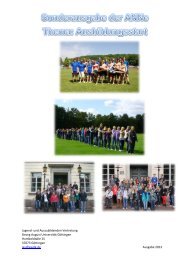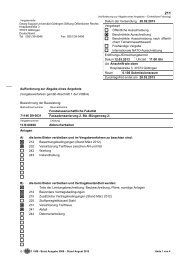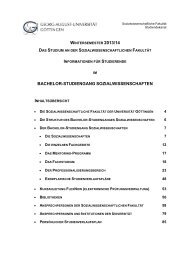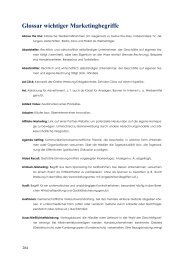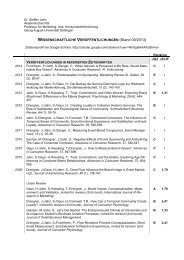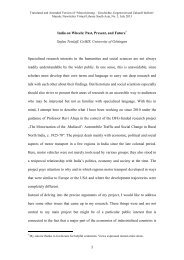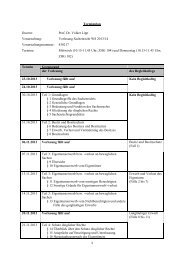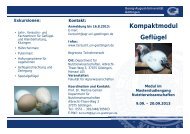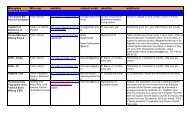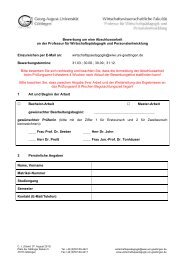CRC 990 - EFForTS - Georg-August-Universität Göttingen
CRC 990 - EFForTS - Georg-August-Universität Göttingen
CRC 990 - EFForTS - Georg-August-Universität Göttingen
You also want an ePaper? Increase the reach of your titles
YUMPU automatically turns print PDFs into web optimized ePapers that Google loves.
<strong>CRC</strong> <strong>990</strong> Ecological and Socioeconomic Functions of Tropical Lowland Rainforest Transformation Systems (Sumatra, Indonesia) Issue 1 / <strong>August</strong> 2013<br />
page 27 von 32<br />
humidity increasing towards higher elevation. The interannual<br />
conditions are influenced by the occurrence<br />
of El Niño event which can lead to severe reduction in<br />
rainfall.<br />
The coring sites are located at different altitudes: 1)<br />
Rore Katimbu (1˚16’44’’ S, 120˚18’34’’ E) situated at about<br />
2400 m a.s.l. within the upper montane forest, 2) Lake<br />
Kalimpaa (1°19’35’’ S, 120°18’32’’ E) at 1700 m a. s. l., within<br />
the mid-montane forest and 3) Lake Lindu (1˚19’16’’S,<br />
120˚04’36’’E) at 1000 m a. s. l. surrounded by sub-montane<br />
forest. The three sites differ in level of human impact<br />
and the records span through the Holocene with<br />
similar temporal resolution.<br />
The multi-sites palaeoecological study allows us to test<br />
the following hypotheses: I) The response of the vegetation<br />
communities to climate change and ENSO events<br />
were different along the altitudinal and moisture gradients;<br />
II) The montane rainforest was impacted by human<br />
activities in the area only in recent times.<br />
The comparative study will lead to a better understanding<br />
of sensitivity/resilience of the LLNP vegetation towards<br />
long term stressed as a consequence of human<br />
activities and climate variability.<br />
Keywords: palynology, charcoal analysis, human impact,<br />
climate change.<br />
B03<br />
Title: Plant genetic diversity in tropical lowland<br />
transformation systems<br />
PRESENTER: Natalie Breidenbach<br />
Tropical rainforests are converted to other types of land<br />
use throughout the globe. The transformation of natural<br />
ecosystems to managed systems frequently results<br />
in a loss of species diversity. In Jambi Province, Sumatera<br />
(Indonesia) tropical lowland rainforests are transformed<br />
into oil palm plantations, rubber plantations<br />
and ‘jungle rubber’. This project explores intraspecific<br />
genetic diversity of vascular plants in reference forests<br />
and the three mentioned transformation systems. In 32<br />
plots (50 x 50 m) of these four different ecosystems, 10<br />
individuals of 10 dominant species are sampled. Based<br />
on anonymous AFLP markers we aim to assess the consequences<br />
of land use changes on the genetic diversity<br />
of plants caused by the different species composition in<br />
each system.<br />
Keywords: Plant genetic diversity, AFLP, transformation<br />
system<br />
B04<br />
Title: Hydraulic architecture of tree<br />
species in cacao agroforests:<br />
Aboveground growth performance<br />
and xylem anatomic properties<br />
PRESENTER: Martyna Kotowska<br />
Wood density and xylem anatomical properties are<br />
usually regarded as core functional traits of tree aboveground<br />
growth performance. Since vessel size affects<br />
sapwood-specific conductivity to the fourth power, a<br />
strong positive correlation to plant growth is to be expected.<br />
Here we examined hydraulic properties of branch, root<br />
and stem tissue of T. cacao and five common shading<br />
tree species (Leucaena leucocephala, Gliricidia sepium,<br />
Gnetum gnemon, Erythrina subumbrans, Durio zibethinus)<br />
from an agroforestry system in Sulawesi, Indonesia.<br />
Our results show that there are significant differences<br />
in specific hydraulic conductivity and hydraulically<br />
weighted vessel diameter between species as well as<br />
between the root, branch and stem xylem within a given<br />
species. Distinct patterns due to the biogeographical<br />
origin of the species are visible. Contrary to recently<br />
published results from primary forests in the same region,<br />
wood density showed a negative relationship to<br />
hydraulic conductivity. On the other hand across all investigated<br />
species basal stem increment was positively<br />
correlated with hydraulic conductivity underlining the<br />
www.uni-goettingen.de/de/310995.html • crc<strong>990</strong>@gwdg.de • Telephone: +49 551 39-1 21 18<br />
JFB Institute for Zoology & Anthropology • Berliner Strasse 28 • D-37073 <strong>Göttingen</strong>




